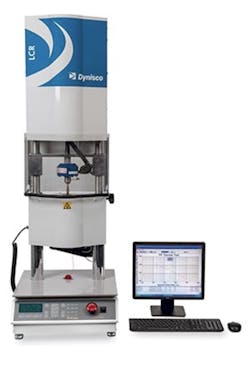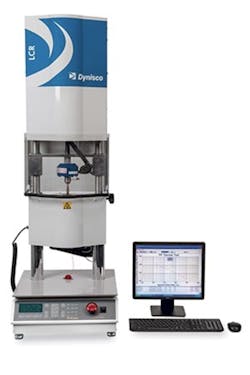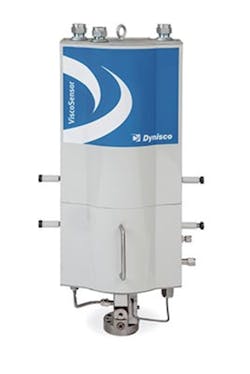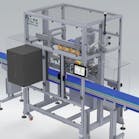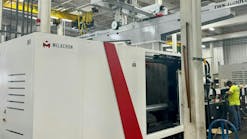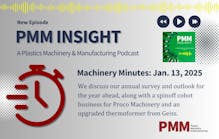Extrusion companies are facing increasing pressure to maximize production, control costs, meet customer-mandated sustainability goals and ensure that their products meet customer specifications, said John Czazasty, director of engineering for Dynisco.
Rheological analytical testing, using melt flow rate testers and capillary rheometers like Dynisco's LCR7000, is growing in popularity to help processors meet those goals, Czazasty told attendees at the Extrusion 2017 conference in Charlotte, N.C., Oct. 18-20. The conference was sponsored by Plastics Technology and Gardner Business Media Inc. Dynisco supplies equipment to the plastics industry for materials testing and extrusion-control monitoring.
Rheological testing most commonly has been done in the lab, but it increasingly is being performed by equipment attached to the extruder with results monitored in real time. Testing can measure melt flow rate, melt volume flow rate, intrinsic and apparent shear viscosity, shear rates and shear stress profiles, he said.
"Quality-control testing of in-process compounds ensures that the failure rate of batches is reduced, thereby offering increased customer retention through reduced scrap production," Czazasty said.Inline sampling of the melt allows an extruder operator to quickly respond to trends that could indicate the material is going out of specification. An operator could, for example, adjust the screw speed, temperature or amount of regrind being blended into the melt, to bring the melt back within specifications.
"That [inline] equipment is not new," he said. "We've had that equipment installed at resin suppliers for decades, but it is new for standard people making plastic parts."
In the past, only compounders producing large amounts of material could afford inline monitoring equipment. The cost for such equipment typically exceeded $100,000, he said.
"You had to have an extremely large plant producing a large amount of materials to justify the expense of making those measurements online in the past, but with new innovations, with Industry 4.0, and with advances in our technology, we're getting that price point down to the point where it makes sense for you," Czazasty said. "We're really excited about this technology."
The company took a large step forward when it recently introduced the Dynisco ViscoIndicator online rheometer, which diverts small samples from an extruder's melt flow for testing.
"The ViscoIndicator is our latest new piece of equipment," Dynisco spokeswoman Catherine Lindquist said in a written statement. "It is a cost-effective bypass online rheometer with IoT capabilities enabling rheological data for the material in the extrusion process to be uploaded to the cloud, providing a window to the process."
The ViscoIndicator sells for a base price of $30,000, she said. The company first unveiled the ViscoIndicator at the K show in 2016.
In addition to the ViscoIndicator, Dynisco also sells the ViscoSensor rheometer. One of the differences between the two machines is that the more expensive ViscoSensor does not produce a waste stream. The tested sample is returned to the process.
The ViscoIndicator does not return the tested material to the process, but has a smaller footprint and is ideal for self-installation since it is easy to set up and integrate into existing or new machinery. The ViscoIndicator produces scrap at a rate of about 1 pound per hour, the company said.
The benefits of adding a ViscoIndicator to an extruder include the ability to track material histories for continuous quality measurement, as well as improved efficiency because operators can make adjustments to adapt to changing conditions, according to the company. The equipment also can help a company decrease its scrap rate by allowing rapid adjustments to changing conditions. Also, the ViscoIndicator may allow operators to increase the use of regrind or wide-spec raw materials with confidence because online testing ensures the finished product will meet customer specifications.
The ViscoIndicator duplicates the test conditions of a laboratory melt flow rate tester or capillary rheometer, according to the company. Melt flow rate and melt viscosity are related to polymer molecular properties, so these numbers give some measure of the physical properties of a resin as well as polymer processability.
"Melt flow rate tests can be correlated with average molecular weight. Moreover, performing the test at various weights can give more information on the material such as molecular weight distribution and shear dependence," Czazasty said. "It is really the standard testing parameter that you can use to tell the quality of plastic."
Testing ensures that process settings are correct and that the processor is not thermally degrading the material, he said. In addition, recycling mandates are forcing processors to include more recycled materials in their products.
"That makes the process more challenging," Czazasty said. "If regrind is being introduced, what percentage should you use? How are you deciding what that percentage is? Melt flow rate will give you a lot of insights into that."
The ViscoIndicator has a single plug-in power connection and can easily connect to an extruder using a common process connection, meaning no modifications to the extruder are needed. In addition, a Windows 10 IoT HMI minimizes the learning curve for operators, as most people already are familiar with the Windows operating system.
In addition to online testing, laboratory equipment such as melt flow rate testers can prove valuable for other applications. For example, a processor buying recycled resin could use the equipment to test its flow properties and confirm the consistency of different batches of the same material.
Bruce Geiselman, senior staff reporter
Contact:
DyniscoFranklin, Mass., 508-541-9400, www.dynisco.com
Bruce Geiselman | Senior Staff Reporter
Senior Staff Reporter Bruce Geiselman covers extrusion, blow molding, additive manufacturing, automation and end markets including automotive and packaging. He also writes features, including In Other Words and Problem Solved, for Plastics Machinery & Manufacturing, Plastics Recycling and The Journal of Blow Molding. He has extensive experience in daily and magazine journalism.

